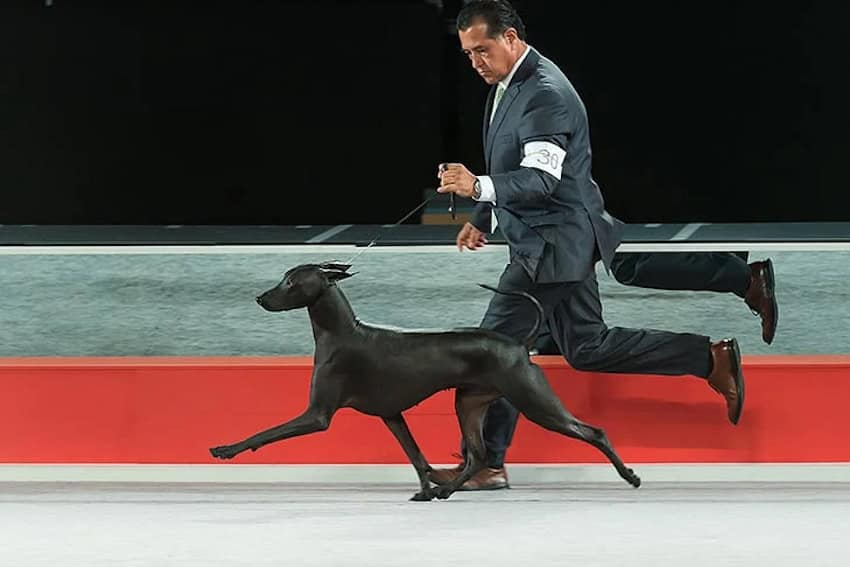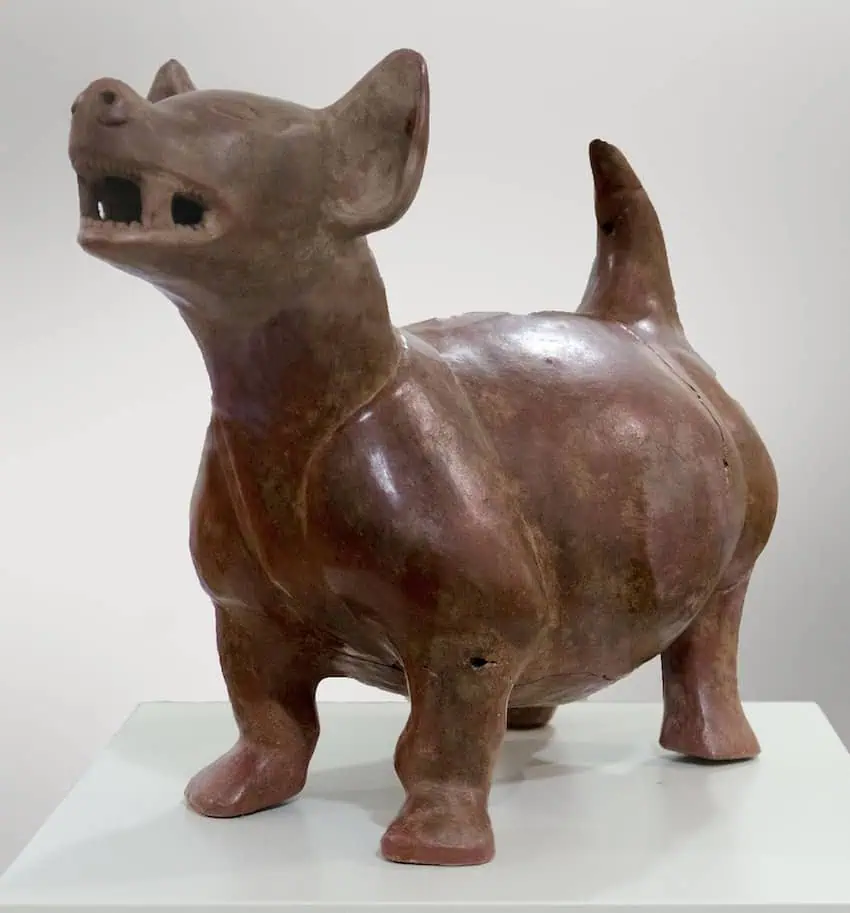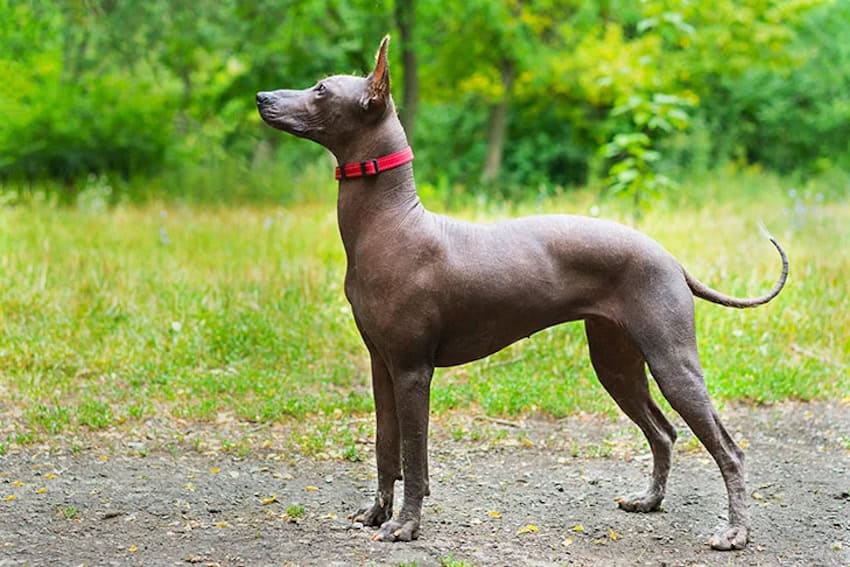You’ve seen them made of ceramic in anthropology museums, featured in Diego Rivera paintings and even as a main character in the Disney hit Coco. The is-it-ugly-or-is-it-cute Mexican hairless dog — el xoloitzcuintli — is one of the oldest documented dog breeds in history and serves today as a symbol of Mexico’s fascinating story.
What is the legend behind the Xoloitzcuintli?
Known affectionately as Xolo (Sho-lo), the name Xoloitzcuintli welds two Nahuatl words: itzcuintli, meaning dog, and Xolotl, the Mexica (Aztec) God and ruler of the dark and taboo, including lightning, twins and fire. Xolotl also leads the dead to Mictlán, or the Underworld.

Who was Xolotl?
According to legend, there were nine layers to pass through to arrive at a new life in Mictlán, one of which was the Apanohuaia River. Crossing this deep, treacherous body of water required the guidance of both Xolotl and a Xolo. The belief was so ingrained into pre-Hispanic society that the dead were commonly buried with sacrificed Xolo dogs to ensure a safe journey. When a dog couldn’t be sacrificed, a small wooden or ceramic statue stood in its place.
Aside from his role as a death doula of sorts, Xolotl had many other roles in pre-Columbian society. He was believed to be the twin brother of Quetzalcoatl, the creator of life. It was Xolotl’s job to lead the sun through the underworld during twilight so it could return safely the next day.
They were hunters.
History depicts Xolos as hunting companions that took down wild turkeys and deer for special occasions and festivals.
They were used as heaters.
Xolos are frequently called “hot water bottles” due to their high body temperatures. The Mexican highlands are known to be cold at night, so families would sleep with their dogs to keep warm.

Their role as a natural “heater” was also thought to heal the ill. Xolos were (and still are) credited with easing the pain of inflammatory diseases like rheumatoid arthritis. As Kay Lawson, a Xolo breeder with 20 years of experience and past president of the Xoloitzcuintli Club of America, told National Geographic in 2017, “They know when you’re sick. They zero right in to where it hurts.”
They were considered a local delicacy.
The Mexica had considered Xolos a ceremonial food source long before the Spanish arrived. However, their place on the occasional dinner plate wasn’t documented until Hernán Cortez wrote about a “prized [canine] delicacy” in his letters to the King of Spain. Cortez did not specifically mention the dogs, but context clues lead historians to believe it was Xolos he was bragging about. In fact, overeating of Xolos may have led to their near-extinction.
It is widely understood that over-consumption by the conquistadors, combined with their waning popularity in modern Mexico, led to a severe decrease in population. Even though Xolos experienced a short revival due to nationalism in the 1920s, with a few dogs making it into the home and artwork of Frida Kahlo and Diego Riviera, it wasn’t until the 1950s that the breed saw signs of regrowth. Norman Pelham Wright led an expedition in Mexico’s remote areas where he and his team found 10 purebreds and incorporated them into an organized breeding program.
It’s hard to say how many Xolos exist today, though some sources claim there are only around 4,000 registered.
The more hairy patches you see, the older the Xolo’s soul.

Xolos are known for being hairless, hence the nickname of “Mexican hairless dog.” Their ears are long and erect and their frame is commonly described as regal. However, there are Xolos with patches of hair on certain parts of their bodies. Some will say it’s genes; the Aztecs will say it’s a sign of reincarnation. The same gene is responsible for the absence of a standard set of teeth.
But not all are hairless.
Xolos can be found in three distinct sizes: miniature, small and standard, measuring less than 14 inches to 23 inches tall. Xolos are usually black, dark gray, brown or even deep red. Some are hairless and others are completely coated, though the hairless breed usually has some tufts of shaggy hair on its head, paws and tail.
They make great service and therapy dogs.
Xolos are intuitive and devoted creatures. If the dog receives strict training and socialization skills from an early age, he or she can make an excellent therapy dog. In an interview with the American Kennel Club, Xolo breeder Stephanie Mazzarella revealed her Xolo’s therapeutic role in her recovery after surviving a car accident. The impacts she suffered were life threatening, from severe anxiety to loss of consciousness. One day, her own Xolo, Neina, sensed that Stephanie was about to lose consciousness before she did. Neina started barking frantically. When Stephanie came to, Neina was licking her face to wake her up.
From this moment, Stephanie started tracking the breed’s ability to connect with patients who suffered from PTSD or autism and found the dogs to be very gentle and protective. Other breeders have stated that Xolos can be trained to detect seizures and summon help when necessary.
They’ve aged gracefully.
Xolos can be dated 3,000 years back. They’re native to Mesoamerica (though there are a few that claim the dog was brought from Asia). Either way, it’s one of the most primitive breeds in the world and also one of the healthiest. Xolos are known to be nearly free from the common health problems found in most domestic dog breeds.
In 2016, then-governor Miguel Ángel Mancera Espinosa, declared the Xoloitzcuintli as the official breed of Mexico City at the request of the Mexican Canine Federation.
Bethany Platanella is a travel planner and lifestyle writer based in Mexico City. She lives for the dopamine hit that comes directly after booking a plane ticket, exploring local markets, practicing yoga and munching on fresh tortillas. Sign up to receive her Sunday Love Letters to your inbox, peruse her blog, or follow her on Instagram.
